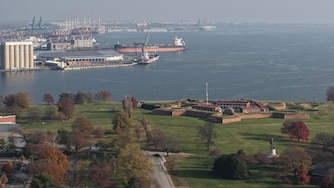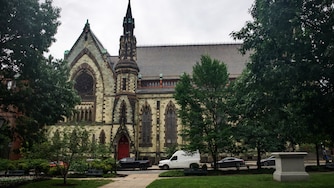Weather permitting, around 200 people are expected to jump into the Baltimore Harbor on Saturday, a reprise of last year’s inaugural Harbor Splash, which drew Mayor Brandon Scott and prominent city boosters into water once infamous for its industrial pollution.
The event is part of a growing trend of people getting their hair wet in the harbor. A year ago, a woman swam 24 miles from the Chesapeake Bay Bridge to the Inner Harbor, a feat she hopes to complete many more times. Events for kayaks, canoes and paddleboards promise to bring even more people in.
For some advocates, these events are the fruits of a 15-year campaign to make the downtown waterfront safe for Baltimoreans to gather to swim, float and cool off.
But others aren’t convinced the harbor — still polluted by sewage overflows and stormwater runoff — is ready.
Environmentalists discuss the question in decidedly different ways.
Optimists such as leaders in City Hall and with Waterfront Partnership, the downtown booster group that organizes Harbor Splash, beckon residents into the water and argue Baltimore is nearing its goal of a harbor clean enough for swimming. Others such as the harbor’s waterkeeper strike a more cautious chord, declining to endorse or disavow public swims while stressing that anyone who jumps in should understand the hazards.
So is the harbor safe for swimming? Really?
“I’d like to have a more streamlined answer, but, honestly, my answer is typically: What day is it?” said Alice Volpitta, Baltimore harbor waterkeeper for the nonprofit Blue Water Baltimore. “There’s no 100%, for-sure risk-free day.”
Blue Water Baltimore, which has championed cleaning the harbor and its watershed since 2010, doesn’t participate in Harbor Splash. The event’s value is as a “mini act of defiance,” Volpitta said, a symbol of “what can be” but not “what currently always is.”
The safety of the harbor for recreation fluctuates wildly with the weather. Whenever it rains, as it has this week, runoff drives litter, animal droppings and other pollutants into the water. It also exacerbates sewage overflows, a key driver of bacteria that, at high enough levels, indicates water that can make people sick.
This is why Adam Lindquist, vice president of Waterfront Partnership and one of the leading proponents of a swimmable Baltimore waterfront, describes the harbor as “conditionally swimmable.”
Even so, Lindquist said, somewhere around 2023 he realized Baltimore had hit a “tipping point” where bacteria levels began to pass state swimming standards almost 80% of the time. That meant officials could start to manage the space for recreation, Lindquist said.
He imagines a future, less than five years out, in which residents can swim freely in roped-off areas of the harbor just about any day of the week.
Many other cities around the country and the world have pursued swimmable waterways.
A decades-long cleanup in Boston Harbor, once an infamous dump, has created a recreation destination. In Washington, advocates have pushed for years for a sanctioned swim in the Anacostia River, where swimming has been outlawed since the early 1970s, though storms have repeatedly delayed their event.
Next week, Lindquist will visit the Netherlands with Katie Pumphrey, the marathon swimmer, for the 2025 Swimmable Cities Summit, a global consortium dedicated to urban waterways.
Eric Schott, an associate professor at the University of Maryland’s Institute of Marine and Environmental Technology, based near the Inner Harbor, swam alongside Lindquist in Fells Point just days ago.
The environmental scientist described conflicted feelings about the harbor’s current safety. Schott cited dramatic improvements in sewage overflows but said getting into the water is a personal choice he makes under controlled conditions.
“Even though I’ve jumped into the harbor a couple of times,” he said, “I wouldn’t recommend it for people. I wouldn’t say it’s something you should just do.”
Waterfront Partnership and Blue Water issue separate report cards each year assessing the harbor’s health. A recent Blue Water report showed its health for underwater life — a different question than human recreation — has declined somewhat in the last decade.
Lindquist, though, has pointed to big strides the harbor has made since the late 2000s, especially in bacteria levels associated with sewage. The city is projected to spend more than $2 billion by 2032 updating its aging wastewater system and preventing overflows, which violate federal water quality laws and which the city agreed to fix under a 2002 federal consent decree.
In April, environmental regulators discovered an improperly connected pipe in Brewer’s Hill had been routing sewage into a storm drain that flows into the harbor “for several months.” How much sewage flowed through this outlet, at the east end of the harbor, isn’t clear.
A spokesperson for the Baltimore Department of Public Works said it is working with the property manager to address the issue.
According to a city consent decree report, a similar issue occurred two years ago in Fells Point, at the same time Waterfront Partnership held a trial Harbor Splash nearby.
Until sewage overflows like these are virtually nonexistent, “we can never say with complete confidence and definitively that the harbor is safe and swimmable,” said Marccus Hendricks, director of the University of Maryland’s Stormwater Infrastructure Resilience and Justice Lab.
Hendricks called achieving a swimmable harbor a worthy goal for everyone in Baltimore, but he added that there may be a “political interest” in making the case that Baltimore is already there.
“To say with confidence that the harbor is swimmable and safely swimmable, I think, may be a stretch,” he said.
Lindquist, though, said these are all reasons Waterfront Partnership is testing bacteria five days a week.
This push to make the harbor safe for recreation has helped get more people invested in clean water, Lindquist said, a growing sentiment that was on display in the outcry over this month’s diesel spill.
“The harbor is a lot cleaner than the average person thinks,” he said. “And I do think it’s really important to communicate that to the public.”
To Schott, the division between advocates for recreation and clean water represents “a healthy tension.” He understands the concern that high-profile events like Harbor Splash might look like “a victory lap.”
“The job is not done. The job would be done when you can swim in the harbor every day without having to worry about testing,” he said. “I don’t think the harbor is going to ever be that place.”
There may be a day when Baltimoreans can enjoy a swimming beach in the Middle Branch, the Patapsco outlet south of the harbor where groups are working to revitalize wetlands, Schott suggested.
But he’s skeptical that the waters near downtown could ever serve as a regular swimming spot.
Still, when it comes to his own choices, the environmental scientist said he has a high tolerance for risk. He’ll be there Saturday, splashing with the rest of them.





Comments
Welcome to The Banner's subscriber-only commenting community. Please review our community guidelines.